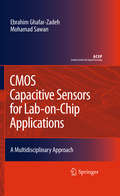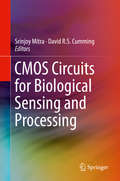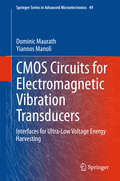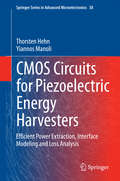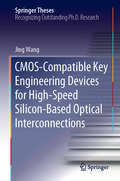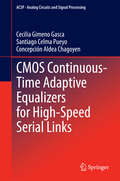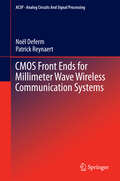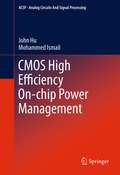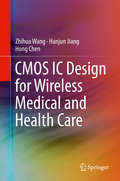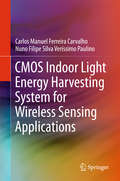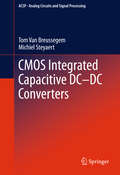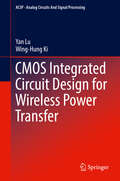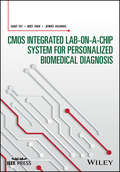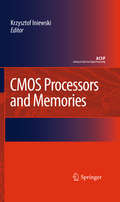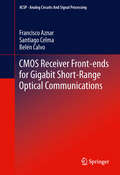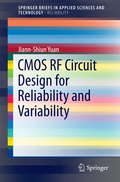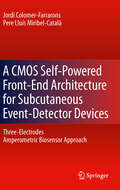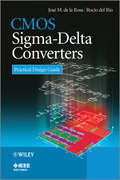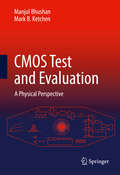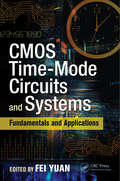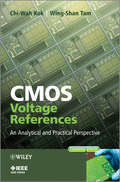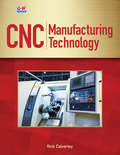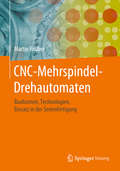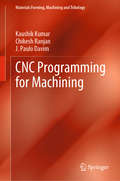- Table View
- List View
CMOS Capacitive Sensors for Lab-on-Chip Applications: A Multidisciplinary Approach (Analog Circuits and Signal Processing)
by Mohamad Sawan Ebrahim Ghafar-ZadehThe main components of CMOS capacitive biosensors including sensing electrodes, bio-functionalized sensing layer, interface circuitries and microfluidic packaging are verbosely explained in chapters 2-6 after a brief introduction on CMOS based LoCs in Chapter 1. CMOS Capacitive Sensors for Lab-on-Chip Applications is written in a simple pedagogical way. It emphasises practical aspects of fully integrated CMOS biosensors rather than mathematical calculations and theoretical details. By using CMOS Capacitive Sensors for Lab-on-Chip Applications, the reader will have circuit design methodologies, main important biological capacitive interfaces and the required microfluidic fabrication procedures to create capacitive biosensor through standard CMOS process.
CMOS Circuits for Biological Sensing and Processing
by Srinjoy Mitra David R. S. CummingThis book provides the most comprehensive and consistent survey of the field of IC design for Biological Sensing and Processing. The authors describe a multitude of applications that require custom CMOS IC design and highlight the techniques in analog and mixed-signal circuit design that potentially can cross boundaries and benefit the very wide community of bio-medical engineers.
CMOS Circuits for Electromagnetic Vibration Transducers: Interfaces for Ultra-Low Voltage Energy Harvesting (Springer Series in Advanced Microelectronics #49)
by Yiannos Manoli Dominic MaurathChip-integrated power management solutions are a must for ultra-low power systems. This enables not only the optimization of innovative sensor applications. It is also essential for integration and miniaturization of energy harvesting supply strategies of portable and autonomous monitoring systems. The book particularly addresses interfaces for energy harvesting, which are the key element to connect micro transducers to energy storage elements. Main features of the book are: - A comprehensive technology and application review, basics on transducer mechanics, fundamental circuit and control design, prototyping and testing, up to sensor system supply and applications. - Novel interfacing concepts - including active rectifiers, MPPT methods for efficient tracking of DC as well as AC sources, and a fully-integrated charge pump for efficient maximum AC power tracking at sub-100aeW ultra-low power levels. The chips achieve one of widest presented operational voltage range in standard CMOS technology: 0. 44V to over 4. 1V. - Two special chapters on analog circuit design ? it studies benefits and obstacles on implemented chip prototypes with three goals: ultra- low power, wide supply voltage range, and integration with standard technologies. Alternative design approaches are pursued using bulk-input transistor stages in forward-bias operation for amplifiers, modulators, and references. - Comprehensive Appendix ? with additional fundamental analysis, design and scaling guidelines, circuit implementation tables and dimensions, schematics, source code listings, bill of material, etc. The discussed prototypes and given design guidelines are tested with real vibration transducer devices. The intended readership is graduate students in advanced courses, academics and lecturers, R&D engineers.
CMOS Circuits for Piezoelectric Energy Harvesters: Efficient Power Extraction, Interface Modeling and Loss Analysis (Springer Series in Advanced Microelectronics #38)
by Yiannos Manoli Thorsten HehnThis book deals with the challenge of exploiting ambient vibrational energy which can be used to power small and low-power electronic devices, e. g. wireless sensor nodes. Generally, particularly for low voltage amplitudes, low-loss rectification is required to achieve high conversion efficiency. In the special case of piezoelectric energy harvesting, pulsed charge extraction has the potential to extract more power compared to a single rectifier. For this purpose, a fully autonomous CMOS integrated interface circuit for piezoelectric generators which fulfills these requirements is presented. Due to these key properties enabling universal usage, other CMOS designers working in the field of energy harvesting will be encouraged to use some of the shown structures for their own implementations. The book is unique in the sense that it highlights the design process from scratch to the final chip. Hence, it gives the designer a comprehensive guide of how to (i) setup an appropriate harvester model to get realistic simulation results, (ii) design the integrated circuits for low power operation, (iii) setup a laboratory measurement environment in order to extensively characterize the chip in combination with the real harvester and finally, (iv) interpret the simulation/measurement results in order to improve the chip performance. Since the dimensions of all devices (transistors, resistors etc. ) are given, readers and other designers can easily re-use the presented circuit concepts.
CMOS-Compatible Key Engineering Devices for High-Speed Silicon-Based Optical Interconnections (Springer Theses)
by Jing WangThis book discusses some research results for CMOS-compatible silicon-based optical devices and interconnections. With accurate simulation and experimental demonstration, it provides insights on silicon-based modulation, advanced multiplexing, polarization and efficient coupling controlling technologies, which are widely used in silicon photonics. Researchers, scientists, engineers and especially students in the field of silicon photonics can benefit from the book. This book provides valuable knowledge, useful methods and practical design that can be considered in emerging silicon-based optical interconnections and communications. And it also give some guidance to student how to organize and complete an good dissertation.
CMOS Continuous-Time Adaptive Equalizers for High-Speed Serial Links (Analog Circuits and Signal Processing #130)
by Santiago Celma Pueyo Cecilia Gimeno Gasca Concepción Aldea ChagoyenThis book introduces readers to the design of adaptive equalization solutions integrated in standard CMOS technology for high-speed serial links. Since continuous-time equalizers offer various advantages as an alternative to discrete-time equalizers at multi-gigabit rates, this book provides a detailed description of continuous-time adaptive equalizers design - both at transistor and system levels-, their main characteristics and performances. The authors begin with a complete review and analysis of the state of the art of equalizers for wireline applications, describing why they are necessary, their types, and their main applications. Next, theoretical fundamentals of continuous-time adaptive equalizers are explored. Then, new structures are proposed to implement the different building blocks of the adaptive equalizer: line equalizer, loop-filters, power comparator, etc. The authors demonstrate the design of a complete low-power, low-voltage, high-speed, continuous-time adaptive equalizer. Finally, a cost-effective CMOS receiver which includes the proposed continuous-time adaptive equalizer is designed for 1. 25 Gb/s optical communications through 50-m length, 1-mm diameter plastic optical fiber (POF).
CMOS Front Ends for Millimeter Wave Wireless Communication Systems (Analog Circuits and Signal Processing)
by Patrick Reynaert Noël DefermThis book focuses on the development of circuit and system design techniques for millimeter wave wireless communication systems above 90GHz and fabricated in nanometer scale CMOS technologies. The authors demonstrate a hands-on methodology that was applied to design six different chips, in order to overcome a variety of design challenges. Behavior of both actives and passives, and how to design them to achieve high performance is discussed in detail. This book serves as a valuable reference for millimeter wave designers, working at both the transistor level and system level.
CMOS High Efficiency On-chip Power Management (Analog Circuits and Signal Processing)
by Mohammed Ismail John HuThis book will introduce various power management integrated circuits (IC) design techniques to build future energy-efficient "green" electronics. The goal is to achieve high efficiency, which is essential to meet consumers' growing need for longer battery lives. The focus is to study topologies amiable for full on-chip implementation (few external components) in the mainstream CMOS technology, which will reduce the physical size and the manufacturing cost of the devices.
CMOS IC Design for Wireless Medical and Health Care
by Hong Chen Zhihua Wang Hanjun JiangThis book provides readers with detailed explanation of the design principles of CMOS integrated circuits for wireless medical and health care, from the perspective of two successfully-commercialized applications. Design techniques for both the circuit block level and the system level are discussed, based on real design examples. CMOS IC design techniques for the entire signal chain of wireless medical and health care systems are covered, including biomedical signal acquisition, wireless transceivers, power management and SoC integration, with emphasis on ultra-low-power IC design techniques.
CMOS Indoor Light Energy Harvesting System for Wireless Sensing Applications
by Carlos Manuel Ferreira Carvalho Nuno Filipe Silva Veríssimo PaulinoThis book discusses in detail the CMOS implementation of energy harvesting. The authors describe an integrated, indoor light energy harvesting system, based on a controller circuit that dynamically and automatically adjusts its operation to meet the actual light circumstances of the environment where the system is placed. The system is intended to power a sensor node, enabling an autonomous wireless sensor network (WSN). Although designed to cope with indoor light levels, the system is also able to work with higher levels, making it an all-round light energy harvesting system. The discussion includes experimental data obtained from an integrated manufactured prototype, which in conjunction with a photovoltaic (PV) cell, serves as a proof of concept of the desired energy harvesting system.
CMOS Integrated Capacitive DC-DC Converters (Analog Circuits and Signal Processing #0)
by Michiel Steyaert Tom Van BreussegemThis book provides a detailed analysis of all aspects of capacitive DC-DC converter design: topology selection, control loop design and noise mitigation. Readers will benefit from the authors' systematic overview that starts from the ground up, in-depth circuit analysis and a thorough review of recently proposed techniques and design methodologies. Not only design techniques are discussed, but also implementation in CMOS is shown, by pinpointing the technological opportunities of CMOS and demonstrating the implementation based on four state-of-the-art prototypes.
CMOS Integrated Circuit Design for Wireless Power Transfer (Analog Circuits and Signal Processing)
by Yan Lu Wing-Hung KiThis book presents state-of-the-art analog and power management IC design techniques for various wireless power transfer (WPT) systems. To create elaborate power management solutions, circuit designers require an in-depth understanding of the characteristics of each converter and regulator in the power chain. This book addresses WPT design issues at both system- and circuit-level, and serves as a handbook offering design insights for research students and engineers in the integrated power electronics area.
CMOS Integrated Lab-on-a-chip System for Personalized Biomedical Diagnosis (Wiley - IEEE)
by Hao Yu Mei Yan Xiwei HuangA thorough examination of lab-on-a-chip circuit-level operations to improve system performance A rapidly aging population demands rapid, cost-effective, flexible, personalized diagnostics. Existing systems tend to fall short in one or more capacities, making the development of alternatives a priority. CMOS Integrated Lab-on-a-Chip System for Personalized Biomedical Diagnosis provides insight toward the solution, with a comprehensive, multidisciplinary reference to the next wave of personalized medicine technology. A standard complementary metal oxide semiconductor (CMOS) fabrication technology allows mass-production of large-array, miniaturized CMOS-integrated sensors from multi-modal domains with smart on-chip processing capability. This book provides an in-depth examination of the design and mechanics considerations that make this technology a promising platform for microfluidics, micro-electro-mechanical systems, electronics, and electromagnetics. From CMOS fundamentals to end-user applications, all aspects of CMOS sensors are covered, with frequent diagrams and illustrations that clarify complex structures and processes. Detailed yet concise, and designed to help students and engineers develop smaller, cheaper, smarter lab-on-a-chip systems, this invaluable reference: Provides clarity and insight on the design of lab-on-a-chip personalized biomedical sensors and systems Features concise analyses of the integration of microfluidics and micro-electro-mechanical systems Highlights the use of compressive sensing, super-resolution, and machine learning through the use of smart SoC processing Discusses recent advances in complementary metal oxide semiconductor-integrated lab-on-a-chip systems Includes guidance on DNA sequencing and cell counting applications using dual-mode chemical/optical and energy harvesting sensors The conventional reliance on the microscope, flow cytometry, and DNA sequencing leaves diagnosticians tied to bulky, expensive equipment with a central problem of scale. Lab-on-a-chip technology eliminates these constraints while improving accuracy and flexibility, ushering in a new era of medicine. This book is an essential reference for students, researchers, and engineers working in diagnostic circuitry and microsystems.
CMOS Processors and Memories (Analog Circuits and Signal Processing)
by Krzysztof IniewskiCMOS Processors and Memories addresses the-state-of-the-art in integrated circuit design in the context of emerging computing systems. New design opportunities in memories and processor are discussed. Emerging materials that can take system performance beyond standard CMOS, like carbon nanotubes, graphene, ferroelectrics and tunnel junctions are explored. CMOS Processors and Memories is divided into two parts: processors and memories. In the first part we start with high performance, low power processor design, followed by a chapter on multi-core processing. They both represent state-of-the-art concepts in current computing industry. The third chapter deals with asynchronous design that still carries lots of promise for future computing needs. At the end we present a "hardware design space exploration" methodology for implementing and analyzing the hardware for the Bayesian inference framework. This particular methodology involves: analyzing the computational cost and exploring candidate hardware components, proposing various custom architectures using both traditional CMOS and hybrid nanotechnology CMOL. The first part concludes with hybrid CMOS-Nano architectures. The second, memory part covers state-of-the-art SRAM, DRAM, and flash memories as well as emerging device concepts. Semiconductor memory is a good example of the full custom design that applies various analog and logic circuits to utilize the memory cell's device physics. Critical physical effects that include tunneling, hot electron injection, charge trapping (Flash memory) are discussed in detail. Emerging memories like FRAM, PRAM and ReRAM that depend on magnetization, electron spin alignment, ferroelectric effect, built-in potential well, quantum effects, and thermal melting are also described. CMOS Processors and Memories is a must for anyone serious about circuit design for future computing technologies. The book is written by top notch international experts in industry and academia. It can be used in graduate course curriculum.
CMOS Receiver Front-ends for Gigabit Short-Range Optical Communications (Analog Circuits and Signal Processing)
by Santiago Celma Pueyo Belén Calvo Lopez Francisco AznarThis book describes optical receiver solutions integrated in standard CMOS technology, attaining high-speed short-range transmission within cost-effective constraints. These techniques support short reach applications, such as local area networks, fiber-to-the-home and multimedia systems in cars and homes. The authors show how to implement the optical front-end in the same technology as the subsequent digital circuitry, leading to integration of the entire receiver system in the same chip. The presentation focuses on CMOS receiver design targeting gigabit transmission along a low-cost, standardized plastic optical fiber up to 50m in length. This book includes a detailed study of CMOS optical receiver design - from building blocks to the system level.
CMOS RF Circuit Design for Reliability and Variability (SpringerBriefs in Applied Sciences and Technology)
by Jiann-Shiun YuanThe subject of this book is CMOS RF circuit design for reliability. The device reliability and process variation issues on RF transmitter and receiver circuits will be particular interest to the readers in the field of semiconductor devices and circuits. This proposed book is unique to explore typical reliability issues in the device and technology level and then to examine their impact on RF wireless transceiver circuit performance. Analytical equations, experimental data, device and circuit simulation results will be given for clear explanation. The main benefit the reader derive from this book will be clear understanding on how device reliability issues affects the RF circuit performance subjected to operation aging and process variations.
A CMOS Self-Powered Front-End Architecture for Subcutaneous Event-Detector Devices: Three-Electrodes Amperometric Biosensor Approach
by Jordi Colomer-Farrarons Pere Lluís Miribel-CatalàA CMOS Self-Powered Front-End Architecture for Subcutaneous Event-Detector Devices presents the conception and prototype realization of a Self-Powered architecture for subcutaneous detector devices. The architecture is designed to work as a true/false (event detector) or threshold level alarm of some substances, ions, etc... that are detected through a three-electrodes amperometric BioSensor approach. The device is envisaged as a Low-Power subcutaneous implantable application powered by an inductive link, one emitter antenna at the external side of the skin and the receiver antenna under the skin. The sensor is controlled with a Potentiostat circuit and then, a post-processing unit detects the desired levels and activates the transmission via a backscattering method by the inductive link. All the instrumentation, except the power module, is implemented in the so called BioChip. Following the idea of the powering link to harvest energy of the magnetic induced link at the implanted device, a Multi-Harvesting Power Chip (MHPC) has been also designed.
CMOS Sigma-Delta Converters
by Rocío Del Río José M. de la RosaA comprehensive overview of Sigma-Delta Analog-to-Digital Converters (ADCs) and a practical guide to their design in nano-scale CMOS for optimal performance.This book presents a systematic and comprehensive compilation of sigma-delta converter operating principles, the new advances in architectures and circuits, design methodologies and practical considerations -- going from system-level specifications to silicon integration, packaging and measurements, with emphasis on nanometer CMOS implementation. The book emphasizes practical design issues - from high-level behavioural modelling in MATLAB/SIMULINK, to circuit-level implementation in Cadence Design FrameWork II. As well as being a comprehensive reference to the theory, the book is also unique in that it gives special importance on practical issues, giving a detailed description of the different steps that constitute the whole design flow of sigma-delta ADCs. The book begins with an introductory survey of sigma-delta modulators, their fundamentals architectures and synthesis methods covered in Chapter 1. In Chapter 2, the effect of main circuit error mechanisms is analysed, providing the necessary understanding of the main practical issues affecting the performance of sigma-delta modulators. The knowledge derived from the first two chapters is presented in the book as an essential part of the systematic top-down/bottom-up synthesis methodology of sigma-delta modulators described in Chapter 3, where a time-domain behavioural simulator named SIMSIDES is described and applied to the high-level design and verification of sigma-delta ADCs. Chapter 4 moves farther down from system-level to the circuit and physical level, providing a number of design recommendations and practical recipes to complete the design flow of sigma-delta modulators. To conclude the book, Chapter 5 gives an overview of the state-of-the-art sigma-delta ADCs, which are exhaustively analysed in order to extract practical design guidelines and to identify the incoming trends, design challenges as well as practical solutions proposed by cutting-edge designs.Offers a complete survey of sigma-delta modulator architectures from fundamentals to state-of-the art topologies, considering both switched-capacitor and continuous-time circuit implementationsGives a systematic analysis and practical design guide of sigma-delta modulators, from a top-down/bottom-up perspective, including mathematical models and analytical procedures, behavioural modeling in MATLAB/SIMULINK, macromodeling, and circuit-level implementation in Cadence Design FrameWork II, chip prototyping, and experimental characterization.Systematic compilation of cutting-edge sigma-delta modulatorsComplete description of SIMSIDES, a time-domain behavioural simulator implemented in MATLAB/SIMULINKPlenty of examples, case studies, and simulation test benches, covering the different stages of the design flow of sigma-delta modulatorsA number of electronic resources, including SIMSIDES, the statistical data used in the state-of-the-art survey, as well as many design examples and test benches are hosted on a companion websiteEssential reading for Researchers and electronics engineering practitioners interested in the design of high-performance data converters integrated in nanometer CMOS technologies; mixed-signal designers.
CMOS Test and Evaluation: A Physical Perspective
by Mark B. Ketchen Manjul BhushanCMOS Test and Evaluation: A Physical Perspective is a single source for an integrated view of test and data analysis methodology for CMOS products, covering circuit sensitivities to MOSFET characteristics, impact of silicon technology process variability, applications of embedded test structures and sensors, product yield, and reliability over the lifetime of the product. This book also covers statistical data analysis and visualization techniques, test equipment and CMOS product specifications, and examines product behavior over its full voltage, temperature and frequency range.
CMOS Time-Mode Circuits and Systems: Fundamentals and Applications (Devices, Circuits, and Systems)
by Fei YuanTime-mode circuits, where information is represented by time difference between digital events, offer a viable and technology-friendly means to realize mixed-mode circuits and systems in nanometer complementary metal-oxide semiconductor (CMOS) technologies. Various architectures of time-based signal processing and design techniques of CMOS time-mode circuits have emerged; however, an in-depth examination of the principles of time-based signal processing and design techniques of time-mode circuits has not been available—until now.CMOS Time-Mode Circuits and Systems: Fundamentals and Applications is the first book to deliver a comprehensive treatment of CMOS time-mode circuits and systems. Featuring contributions from leading experts, this authoritative text contains a rich collection of literature on time-mode circuits and systems.The book begins by presenting a critical comparison of voltage-mode, current-mode, and time-mode signaling for mixed-mode signal processing and then: Covers the fundamentals of time-mode signal processing, such as voltage-to-time converters, all-digital phase-locked loops, and frequency synthesizers Investigates the performance characteristics, architecture, design techniques, and implementation of time-to-digital converters Discusses time-mode delta-sigma-based analog-to-digital converters, placing a great emphasis on time-mode quantizers Includes a detailed study of ultra-low-power integrated time-mode temperature measurement systems CMOS Time-Mode Circuits and Systems: Fundamentals and Applications provides a valuable reference for circuit design engineers, hardware system engineers, graduate students, and others seeking to master this fast-evolving field.
CMOS Voltage References: An Analytical and Practical Perspective (Wiley - IEEE)
by Chi-Wah Kok Wing-Shan TamA practical overview of CMOS circuit design, this book covers the technology, analysis, and design techniques of voltage reference circuits. The design requirements covered follow modern CMOS processes, with an emphasis on low power, low voltage, and low temperature coefficient voltage reference design. Dedicating a chapter to each stage of the design process, the authors have organized the content to give readers the tools they need to implement the technologies themselves. Readers will gain an understanding of device characteristics, the practical considerations behind circuit topology, and potential problems with each type of circuit. Many design examples are used throughout, most of which have been tested with silicon implementation or employed in real-world products. This ensures that the material presented relevant to both students studying the topic as well as readers requiring a practical viewpoint. Covers CMOS voltage reference circuit design, from the basics through to advanced topics Provides an overview of basic device physics and different building blocks of voltage reference designs Features real-world examples based on actual silicon implementation Includes analytical exercises, simulation exercises, and silicon layout exercises, giving readers guidance and design layout experience for voltage reference circuits Solution manual available to instructors from the book’s companion website This book is highly useful for graduate students in VLSI design, as well as practicing analog engineers and IC design professionals. Advanced undergraduates preparing for further study in VLSI will also find this book a helpful companion text.
CNC Manufacturing Technology
by Rick CalverleyCNC Manufacturing Technology helps to prepare learners for entry-level CNC technician positions in today’s advanced manufacturing industry. Early foundational chapters create an awareness of career opportunities, stress the importance of shop safety, and show how math is used in machining. Subsequent chapters develop a broad base of knowledge of basic machining skills such as print reading and the use of measuring instruments. The author employs a building-block approach to present in-depth coverage of CNC equipment, cutting tools and inserts, CNC mill and CNC lathe programming, CAM, multiaxis programming, and additional advanced topics. Extensive use of artwork, photographs, and code examples help students to visualize CNC programming and equipment operation.
CNC-Mehrspindel-Drehautomaten: Bauformen, Technologien, Einsatz in der Serienfertigung
by Martin ReuberDieses Fachbuch belegt, dass der moderne CNC-Mehrspindel-Drehautomat eine außerordentlich hohe Produktivität mit den wesentlichen Merkmalen einer flexiblen Fertigung vereint. Es vermittelt grundlegende Kenntnisse über die Maschinen- und Prozesstechnologie, stellt auf Mehrspindlern eingesetzte Technologien und Anwendungen vor und erläutert die spezifischen Besonderheiten und Anforderungen der mehrspindligen Produktion. Es wird dargestellt, welche Potenziale und Wettbewerbsvorteile sich mit innovativen Maschinenkonzepten und Fertigungstechnologien erschließen und erzielen lassen.
CNC Programming for Machining (Materials Forming, Machining and Tribology)
by J. Paulo Davim Kaushik Kumar Chikesh RanjanThe book is basically written with a view to project Computer Numerical Control Programming (CNC) Programming for machines. This book shows how to write, read and understand such programs for modernizating manufacturing machines. It includes topics such as different programming codes as well as different CNC machines such as drilling and milling.
Co-benefits of Sustainable Forestry: Ecological Studies of a Certified Bornean Rain Forest (Ecological Research Monographs)
by Kanehiro KitayamaTropical rain forests are increasingly expected to serve for climate change mitigation and biodiversity conservation amid global climate change and increasing human demands for land. Natural production forests that are legally designated to produce timber occur widely in the Southeast Asian tropics. Synergizing timber production, climate change mitigation and biodiversity conservation in such tropical production forests is one of the most realistic means to resolve these contemporary global problems. Next-generation sustainable forest management is being practiced in the natural tropical rain forest of a model site in Sabah, Malaysian Borneo, while earlier sustainable management practices have generally failed, leading to extensive deforestation and forest degradation elsewhere in the tropics. Ecologists have examined co-benefits of sustainable forestry in the model forest in terms of forest regeneration, carbon sequestration and biodiversity in comparison to a forest managed by destructive conventional methods. Taxonomic groups studied have included trees, decomposers, soil microbes, insects and mammals. A wide array of field methods and technology has been used including count plots, sensor cameras, and satellite remote-sensing. This book is a compilation of the results of those thorough ecological investigations and elucidates ecological processes of tropical rain forests after logging. The book furnishes useful information for foresters and conservation NGOs, and it also provides baseline information for biologists and ecologists. A further aim is to examine the environmental effects of a forest certification scheme as the model forest has been certified by the Forest Stewardship Council. Taken as a whole, this book proves that the desired synergy is possible.
